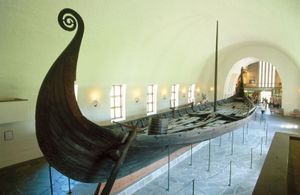Our editors will review what you’ve submitted and determine whether to revise the article.
News •
Viking society, which had developed by the 9th century, included the peoples that lived in what are now Denmark, Norway, Sweden, and, from the 10th century, Iceland. In the beginning, political power was relatively diffused, but it eventually became centralized in the respective Danish, Norwegian, and Swedish kingdoms—a process that helped to bring about the end of the Viking era. Although a lot more is known about Viking society than about the earlier peoples in Denmark, the society was not a literate one, runic inscriptions notwithstanding. Some information about the era has thus been gleaned from the Vikings’ apparently rich oral tradition, portions of which were later recorded in poems such as Beowulf and in sagas such as Heimskringla.
The Vikings were superb shipbuilders and sailors. Although they are thought of primarily as raiders, they also engaged in a great deal of trade. In both capacities they traveled widely along routes that stretched from Greenland and North America in the west to Novgorod (now in Russia), Kiev (now in Ukraine), and Constantinople (now Istanbul, Tur.) in the east, as well as from north of the Arctic Circle south to the Mediterranean Sea. The Viking trade routes, especially those along the Russian river system, linked northern Europe to both the Arab trading network and the Byzantine Empire. The major goods moving east were slaves, furs, and amber while those traveling west included precious metals, jewels, textiles, and glassware. Danes, for the most part, occupied the center of this system; they generally traveled west to England and south along the coast of France and the Iberian Peninsula.
In addition to raiding and trading, Vikings established settlements, which at first may have served mainly as winter quarters while abroad. The Danes moved primarily to the eastern part of England that came to be called the Danelaw; this region stretched from the River Thames north through what became known as Yorkshire. It appears that a good number of Scandinavian women accompanied their men to England and also settled there. The other major area of Danish Viking settlement was in Normandy, France. In 911 the Viking leader Rollo became the first duke of Normandy, as a vassal of Charles III of France. While the nationality of Rollo is in dispute—some sources say Norwegian and others say Danish—there is no question that most of his followers were Danes, many from the Danelaw area. Unlike the Danes in England, Rollo’s men did not bring many Viking women to France; most of the warriors married local women, resulting in a mixed Danish-Celtic culture in Normandy (see also Celt).
In the midst of the Viking era, in the first half of the 10th century, the kingdom of Denmark coalesced in Jutland (Jylland) under King Gorm the Old. Gorm’s son and successor, Harald I (Bluetooth), claimed to have unified Denmark, conquered Norway, and Christianized the Danes. His accomplishments are inscribed in runic on a huge gravestone at Jelling, one of the so-called Jelling stones. Harald’s conquest of Norway was short-lived, however, and his son Sweyn I (Forkbeard) was forced to rewin the country. Sweyn also exhausted England in annual raids and was finally accepted as king of that country, but he died shortly thereafter. Sweyn’s son Canute I (the Great) reconquered Norway, which had been lost around the time of Sweyn’s death in 1014, and forged an Anglo-Danish kingdom that lasted until his own death in 1035. Various contenders fought for the throne of England and held it for short periods until the question of the succession was settled in 1066 by one of Rollo’s descendants, William I (the Conqueror), who led the Norman forces to victory over the last Anglo-Saxon king of England, Harold II, at the Battle of Hastings (see Norman Conquest).
Throughout the Viking period, Danish social structures evolved. Society was likely divided into three main groups: the elite, free men and women, and thralls (slaves). Over time, differences among members of the elite increased, and by the end of the period the concept of royalty had emerged, the status of the elite was becoming inheritable, and the gap between the elite and the free peasantry had widened. Slavery did not last past the Middle Ages.
There has been much debate among scholars about the role and status of Viking women. Though the society was clearly patriarchal, women could initiate divorce and own property, and some exceptional women assumed leadership roles in their home communities. Women also played important economic roles, as in the production of woolen cloth.
While no clear line can be drawn, the Viking era had ended by the middle of the 11th century. Many have credited the Christianization of the Scandinavians with bringing about the end of Viking depredations, but the centralization of temporal power also contributed significantly to the decline of the Vikings. Canute the Great, for example, gathered relatively large armies under his control rather than allowing small warrior bands to join him at will—as was the Viking tradition. In fact, Canute and other Nordic kings—behaving more like feudal overlords than mere head warriors—worked to inhibit the formation of independent warrior bands in the Scandinavian homelands. The increasing power of the Mongols on the Eurasian Steppe also affected the Vikings’ dominance. As the Mongols moved farther west, they closed the Vikings’ eastern river routes, which southern and central European merchants increasingly replaced with overland and Mediterranean routes. Nevertheless, there can be no doubt that the Christian church shaped the emerging society and culture of medieval Denmark and of Scandinavia as a whole.





























